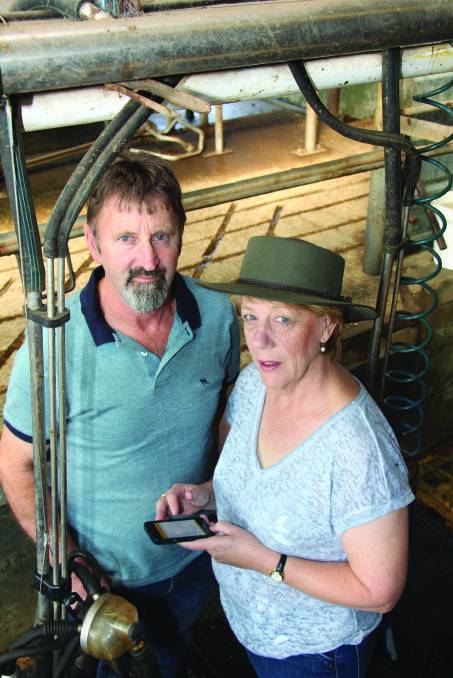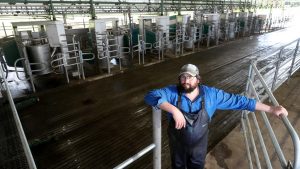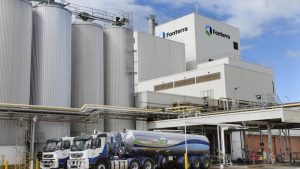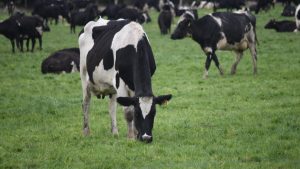
The Larpent, Vic, dairy farmers operate Calderbrae Holsteins, a Master Breeder herd, which peaks at 180 cows across 100 hectares.
The couple use DataGene’s HerdData and Good Bulls apps and these are backed-up by dairy herd management software Mistro Farm.
“I’ve always thought of Mistro Farm as a client management system, but for cows,” Mrs Suares said.
“All the information you need for each person or cow has to be there when you need it; and you can generate useful management reports.”
Drawing on her experience working off-farm in the disability sector, Mrs Suares said the DataGene apps had a lot of similarities with other programs.
“For the last few years working, our client management system (at off-farm work) was web-based and you could access a person’s information on the i-pad when you are with the person out in the field,” she said.
“I see the HerdData app as the same thing; it gives you the capacity to access the information you need when you need it, on the phone.”
The Suares’s mainly use of HerdData to identify which cows should be dried-off and what ones need to be culled.
To determine a dry-off time, the couple looks at how many days a cow has been in-milk and when it is due to calve. Its joining, pregnancy test and treatment data gets entered via the computer, which synchs to the app. Production and cell count information gets sent to the app following herd recording.
“‘Like all data systems, the HerdData app and Mistro farm are garbage in-garbage out their usefulness depends entirely on the quality and quantity of information you put into them as a farmer,” Mrs Suares said.
“You really need to be prepared to spend the time inputting the information you want to be able to access, so that you can extract value to your operation from them.”
The app not only saves time, it ensures the right cows are culled.
“When we are picking cows, Wednesday night before chopper day, and a few need to go, we can always look up their cell count and how long they have been in.
“It is at your finger-tips if you need it,” she said.
Mr Suares also works as a stock agent and sometimes this means they are both are away from the farm. Mrs Suares said she used the downtime while travelling to look through the herd records on the app and make “to do” lists for when they get home.
“We can make more informed decisions,” she said.
Data has always played a huge role in the Suares family farm. They herd record regularly and have done since they are started in the industry as sharefarmers.
“You can’t improve on what you don’t measure,” Mrs Suares said.
“With some cows, how do you know if you are selling or keeping the right cow if you don’t always measure? You have an idea by looking at a cow, but you have no idea about the butterfat and protein she’s producing or her cell count. At the end of the day, it is milk solids which count, not milk volume.”
The HerdData app is also used for general farm management and it helps with farm audits.
“We are starting to use the paddock diary to keep records of what chemicals have been sprayed on which paddock, fertiliser applications and what’s planted where,” she said.
“You can record who milked, cow treatments and antibiotics used so when its audit time you can generate a report, which generally provides the auditors with all the information they require. It saves time and looks a whole lot more professional.”
The Suares also use the Good Bulls Guide app, primarily at joining time.
They classify their herd regularly through Holstein Australia. They use this classification summary of their herd, which highlights both the strong and weak points, to make breeding decisions.
Mrs Suares said the classification highlighted “issues they need to watch” and these were considered and used as a starting-point for their breeding selection criteria.
Calderbrae Holsteins use the Data-Gene Balanced Performance Index (BPI) list to select sires and have a specific list of traits which they would not “go below 96” with. These include, size the Suares like to maintain a cow about 600kg to maintain a margin over feed costs capacity, including chest and muzzle width, feet, legs and mammary system.
They have also focused on selecting bulls that only produce the A2 protein. Mr Suares said there was a premium in the market for these animals and they both believed there would be a strong future for the differentiated A2 products.
The Suares use a combination of genomic and proven sires. Mrs Suares said they liked to investigate cow families, but fundamentally objective information provided the starting point for breeding decisions. “We start with what the data says and then go from there,” she said.
“It is much quicker, you could spend days and days going through bull catalogues.”
The Suares also set their Good Bulls Guide app to avoid certain bloodlines to ensure subject to availability they can use all the bulls which are recommended to them by the app.
They do not like to use common bloodlines they have used extensively in the past. This helps them avoid issues with inbreeding.
“With the app it really is just setting your own criteria,” Mrs Suares said.
“The app comes up with a list and then, from there, we will look at the catalogues and pedigrees.” The apps have helped save time on the farm and ensure the Suareses are more confident with their breeding decisions.
“Decisions have got to be better, we are using the data and information effectively,” Mrs Suares said.
“This takes the emotion out of it and allows us to be more objective about things. It gives us more confidence in our decision making.”
The Suareses never set-out to farm registered cattle.
In the early 1990s they went to a dispersal sale in Gippsland. At the time the region was in severe drought and they bought a line of registered yearling heifers from the Quantock stud.
What was an “accident” turned out to be a good business decision as the cow families that came from those 15 heifers remain in the herd today, including a cow classified excellent 3E.
Calderbrae heifers calving this autumn were joined to calving ease and short gestation bull Russian. Other sires used across the herd in recent years include MVP, Balisto.
Overtime, Dean Cox, Atley and, for the Red Holsteins, Apple Pie have been used.
Each year about 25 per cent of the herd is replaced and it’s with these the youngest animals that the couple gauges breeding success.
“As long as we see an improvement in our heifers every year, we are happy,” Mr Suares said.























